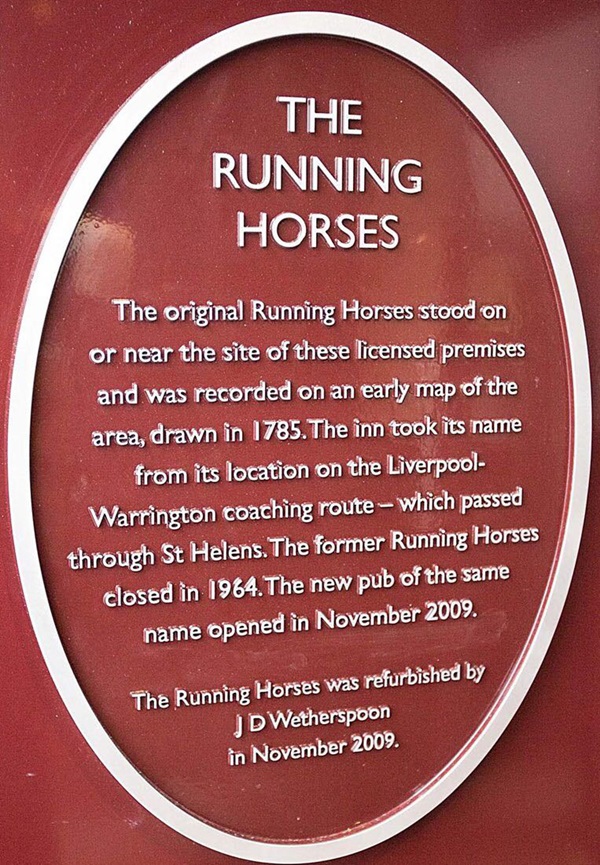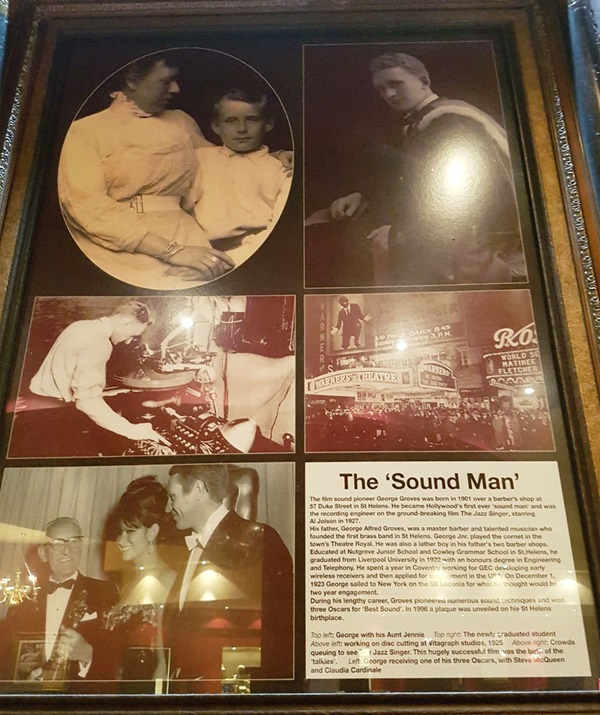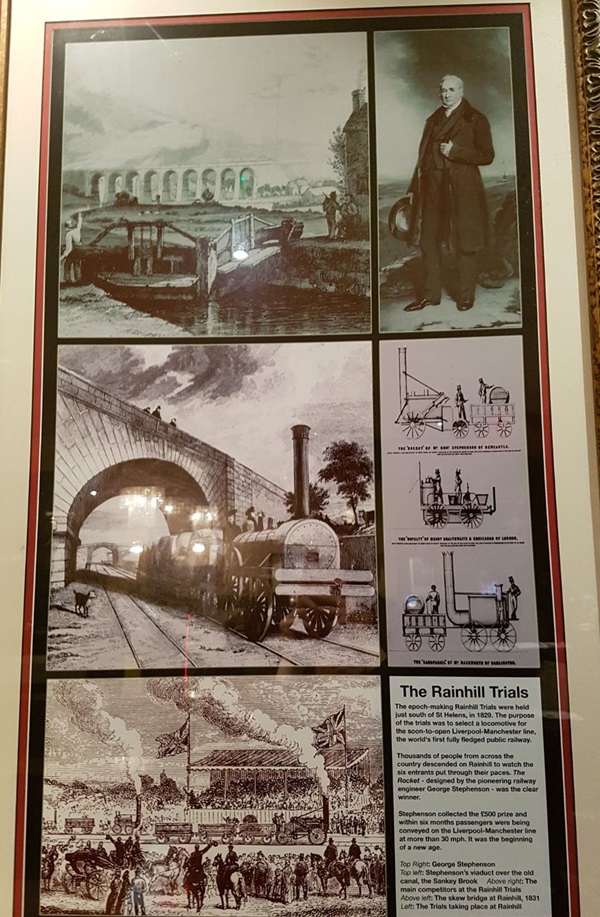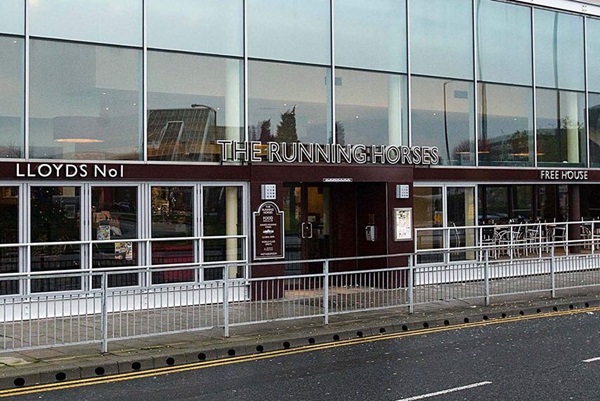This pub is closed permanently. Your nearest Wetherspoon pub: The Glass House
In older, quieter times, the coaching route from Liverpool to Warrington passed through this junction. Passengers stopped for refreshments here. The unusually named inn was probably built in the late 18th century and stood on the site of today’s entertainment complex. The earliest recorded licensee was James Bridge in 1790. The old coaching inn eventually became part of Greenall’s pub/hotel empire (founded in St Helens). The Running Horses closed its doors for the last time in April 1964.
Photographs and text about The Running Horses.

The text reads: These licensed premises look out across the busy road junction, where the old and new ring roads meet (Linkway and Chalon Way West). The coaching route from Liverpool to Warrington, where travellers stopped for refreshments at The Running Horses.
The Running Horses was very conveniently placed at what was originally known as Kitts Bridge, a wooden bridge built over the local brook at the junction of Bridge Street, Tontine Street and Liverpool Road. The inn was set well back from the road, with a smithy at the rear and a large timber yard directly opposite. The first recorded licensee, in 1790, was James Bridge.
Very few public houses have carried this name. Usually the name refers to wild horses, and The Running Horses at St Helens may have gained its name from the adjacent fields, where wild horses grazed during the 1700s. However, in this case, the name could refer to the stagecoaches on the route from Warrington via St Helens to Prescot and Liverpool, which once passed through this junction.
Top: Liverpool Road looking up Bridge Street. The Running Horses is behind the horse and card, c1890.
Above right: The Running Horses in Liverpool Road (the building with the pointed gable and bay window below), c1890
Above left: Men congregating in the doorway of The Running Horses, c1890
Left: The Prescot-bound tram is approaching the bottom of Bridge Street close to The Running Horses.
A plaque documenting the history of The Running Horses.

The plaque reads: The original Running Horses stood on or near the site of these licensed premises and was recorded on an early map of the area, drawn in 1785. The inn took its name from its location on the Liverpool-Warrington coaching route – which passed through St Helens. The former Running Horses closed in 1964. The new pub of the same name opened in November 2009.
The Running Horses was refurbished by J D Wetherspoon in November 2009.
Photographs and text about a Victorian mass murder in Rainhill.

The text reads: Rainhill was the location of a notorious Victorian mass murder. In March 1892, the bodies of a woman and her four children were discovered buried under the concrete floor of Dinham Villa, Lawton Road, Rainhill.
The series of events that led to this gruesome discovery began when Frederick Bailey Deeming married Emily Mather in St Ann’s Church, Rainhill. The couple emigrated to Australia, where Deeming murdered his wife and buried her under the floor of their kitchen. Australian police contacted Scotland Yard and, as a result of information passed onto them, they made a search of Dinham Villa, where Deeming had lived with a woman who passed for his sister, and her four children. Marie Deeming, however, was his first wife. Her throat had been cut, as had the throats of three of the children. The fourth was strangled.
Deeming was convicted of the murder of Emily Mather and hanged in Australia. Dinham Villa in Rainhill was demolished. The Rainhill victims were interred in the graveyard of St Ann’s Church. Sadly, the headstone marking their grave was stolen, so now it is unmarked.
Above: Frederick Bailey Deeming, serial killer
Right: top, the kitchen at Dinham Villa after the bodies had been removed
Below: The perfectly normal-looking house where the carnage occurred.
Photographs and text about George Groves.

The text reads: The film sound pioneer George Groves was born in 1901 over a barber’s shop at 57 Duke Street in St Helens. He became Hollywood’s first ever ‘sound man’ and was the recording engineer on the ground-breaking film The Jazz Singer, starring Al Jolson in 1927.
His father, George Alfred Groves, was a master barber and talented musician who founded the first brass band in St Helens. George Jnr. played the cornet in the town’s Theatre Royal. He was also a lather boy in his father’s two barber shops.
Educated at Nutgrove Junior School and Cowley Grammar School in St Helens, he graduated from Liverpool University in 1922 with an honours degree in Engineering and Telephony. He spent a year in Coventry working for GEC developing early wireless receivers and then applied for employment in the USA. On December 1, 1923 George sailed to New York on the SS Laconia for what he thought would be a two year engagement.
During his lengthy career, Groves pioneered numerous sound techniques and won three Oscars for Best Sound. In 1996 a plaque was unveiled on his St Helens birthplace.
Top left: George with his Aunt Jennie
Top right: The newly graduated student
Above left: working on disc cutting at Vitagraph studios, 1925
Above right: Crowds queuing to see The Jazz Singer. This hugely successful film was the birth of the ‘talkies’
Left: George receiving one of his three Oscars, with Steve McQueen and Claudia Cardinale.
Illustrations and prints about the Rainhill Trials.

The text reads: The epoch-making Rainhill Trials were held just south of St Helens, in 1829. The purpose of the trials was to select a locomotive for the soon-to-open Liverpool-Manchester line, the world’s first fully fledged public railway.
Thousands of people from across the country descended on Rainhill to watch the six entrants put through their paces. The Rocket – designed by the pioneering railway engineer George Stephenson – was the clear winner.
Stephenson collected the £500 prize and within six months passengers were being conveyed on the Liverpool-Manchester line at more than 30mph. It was the beginning of a new age.
Top right: George Stephenson
Top left: Stephenson’s viaduct over the old canal, the Sankey Brook
Above right: The main competitors at the Rainhill Trials
Above left: The skew bridge at Rainhill, 1831
Left: The Trials taking place at Rainhill.
External photograph of the building – main entrance.

If you have information on the history of this pub, then we’d like you to share it with us. Please e-mail all information to: pubhistories@jdwetherspoon.co.uk